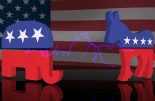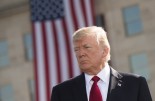BlueBay Asset Management: Blue ripple pushes Wall Street to new highs
BlueBay Asset Management: Blue ripple pushes Wall Street to new highs
Mark Dowding, CIO at BlueBay Asset Management, has issued his latest market commentary, in which he focusses on the recent US Senate elections, the latest developments in Coronavirus vaccines and a “K”-shaped economic recovery for 2021.
Key highlights include:
- US fiscal spending: Following the Democrats gaining of control of the Senate, BlueBay is inclined to look for an additional USD1-2 trillion in fiscal spending in the coming year, which should lift 2021 GDP forecasts.
- Covid and reflationary trades: The spike in Covid infections represent a downside risk to Q1 growth data. As a result, BlueBay believes that policymakers will remain focused on delivering policy stimulus.
- Macro view: BlueBay’s stance remains modestly short duration on US Treasuries and long in corporate and sovereign credit.
- FX: This environment should generally see the dollar slightly weaker, though it may now be set for renewed growth outperformance as we move through 2021.
- Economic recovery: Robust growth in the broader economy could coincide with a more challenging landscape for financial assets
Markets continue to rally while Washington hits a new low.
Victory for Democrat candidates in the Georgia run-offs has seen the party take de-facto control of the US Senate, with Vice President Harris set to act as the tie-breaker in an evenly divided assembly.
At the time of the November elections, this seemed to represent a relatively unlikely scenario in the eyes of many commentators, yet it appears that the behaviour of outgoing President Trump has only served to rally the Democrat base and drive-up the turnout in blue-leaning districts. With the incoming Biden Administration now having authority over all three branches of the Executive, this has seen investors react to a perceived ‘blue wave’ by pushing Treasury yields higher and the yield curve steeper.
We would concur with the sentiment that this result should lead to a more fiscally expansive outcome than under a GoP-controlled Senate and have been highlighting upside risks from a more assertive fiscal stance with Yellen at the Treasury for the past couple of months. The ability for the Democrats to control what is debated on the Senate floor should also help to eliminate deadlock, even if we believe that it is unlikely that there will be a push to end the 60-vote filibuster.
In aggregate, we are inclined to look for an additional USD1–2 trillion in fiscal spending in the coming year and this should lift 2021 GDP forecasts. At the same time, we would highlight that despite party unity in their collective disgust at Trump, the Democratic Party remains deeply divided between moderates and liberal progressives – in many respects more divided than is the case for the Republican movement.
Bearing this in mind, we think it is unlikely much of the more expansive or radical aspects of the Biden agenda will see the light of day. For example, policies aimed at increased regulation on the energy sector, banks and big tech are all likely to be watered down in the face of state-level opposition.
We also believe that material tax rises are unlikely and may be unnecessary. Consequently, risk assets have not been greatly perturbed by US political developments in recent days, nor by somewhat higher yields – though this is on the assumption that moves in rates are largely contained by the Federal Reserve not wanting to see a premature tightening of financial conditions when the real economy is still in the midst of dealing with the worst of the pandemic. In this sense, we would rather characterise recent developments as more of a ‘blue ripple’ than a ‘blue wave’.
Vaccines roll out
Newsflow with respect to Covid has become increasingly concerning over the past several weeks, as new variants appear to accelerate the spread of infections and necessitate more draconian lockdown measures in order to contain the virus.
Vaccine deployment is now underway in most developed countries, though logistical and administrative deficiencies mean that there is a building sense of frustration that this is not occurring at a more rapid pace. In a small country like Israel, it has been possible to vaccinate 15% of the population already through a commitment to deliver shots around the clock, seven days a week. However, it does not appear many other countries have adopted the same sense of urgency, though in the days ahead it will be interesting to see whether in countries like the UK, which has approved the Oxford-AstraZeneca vaccine, this can be accelerated.
Notwithstanding this, it seems that the spike in Covid infections and measures taken to limit this, represent a downside risk to Q1 growth data. From this point of view, we believe that policymakers will remain focused on delivering policy stimulus where they can, in order to support economic output. Consequently, bad news on Covid may be seen as a delay rather than a reversal of reflationary trades. Should risk assets experience a pullback, we suspect that this will be bought, with US investors already talking about the mighty ‘J&J put’ (Jerome & Janet).
New year, same scenario
In this respect, we feel as if 2021 is starting in a similar fashion to how 2020 finished. The narrative of policy support for the near term and hopes for stronger growth for the long term have created market-friendly conditions over recent months. This would be challenged if policymakers appeared to step back from providing additional support, but this is not even conscionable for the time being. For now, any bad news on the virus will be translated into expectations of further easing and therefore further asset purchases.
By contrast, the one threat which could really change this narrative would be an outcome that suggests that vaccines are not as effective as hoped for, given how dependent the world now is on vaccines as the only effective answer to address the pandemic. Thankfully for now, it appears that this is not a material risk with respect to the English mutation, but there may be a risk of lower vaccine effectiveness with respect to the new strain circulating in South Africa.
Our macro stance remains modestly short duration in US Treasuries and long in corporate and sovereign credit. We remain inclined to realise gains on positions which have worked well and have been trimming long risk in long-dated Italian BTPs over the past week, with periphery spreads at their recent tights. We continue to look for opportunities selectively in new issues and are generally inclined to increase our focus on relative-value positions. We expect material divergence at an issuer and sector level during the months ahead on the back of divergent economic and financial performance.
Looking ahead
We continue to believe that the market narrative will remain largely the same for the next couple of months, though following the rally in spreads in the past quarter, any further compression is now likely to be a much slower grind. We expect US yields to rise over the medium term, but the Covid backdrop means that moves may be muted for now.
In FX, we feel this environment should generally see the dollar slightly weaker, though having witnessed a period when the US was seen as a potential underperformer on the back of the spread of the virus across the states, it may now be set for renewed growth outperformance as we move through 2021. This may temper the extent to which the weak dollar trend has further to run.
We believe that the bigger test will come once markets sense they have passed the high watermark for policy accommodation. In the second half of the year, we believe that we may see much stronger growth data on the back of pent-up demand. Although it is unlikely that policy will be tightened anytime soon, the mere fact that there won’t be additional easing beyond this point may be enough to trigger a correction.
We wrote at length on the ‘K’ shaped trajectory in 2020, during which period Wall Street drove higher, even as main street continued to struggle. Later in 2021, this ‘K’ shape could operate in reverse. Robust growth in the broader economy could coincide with a more challenging landscape for financial assets and we believe that it will be important to have positioned well in advance of this potential turning point. However, for now, the virus may have pushed out this inflection point by a few more months and we believe that the 2020 playbook largely remains intact.
It feels that for many of us, the next few weeks may represent a pretty hard slog with quality of life rather compromised at a time of year when the weather is miserable and the days are short. But sunnier times lie in wait and it seems like we need to stay patient. Trump has now got less than two weeks left to create mischief and hopefully following scenes this week he will think twice before inciting protest and tarnishing his sullied reputation ever further.








